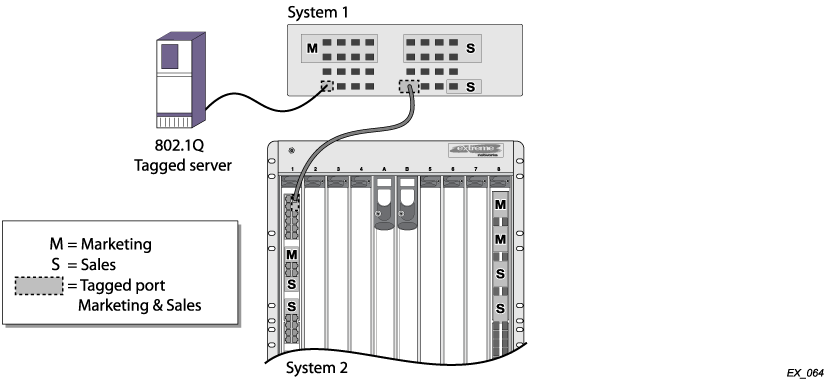
Note
The use of 802.1Q tagged packets may lead to the appearance of packets slightly bigger than the current IEEE 802.3/Ethernet maximum of 1,518 bytes. This may affect packet error counters in other devices and may also lead to connectivity problems if non-802.1Q bridges or routers are placed in the path.Tagging is most commonly used to create VLANs that span switches.
The switch-to-switch connections are typically called trunks. Using tags, multiple VLANs can span multiple switches using one or more trunks. In a port-based VLAN, each VLAN requires its own pair of trunk ports, as shown in Physical Diagram of Tagged and Untagged Traffic. Using tags, multiple VLANs can span two switches with a single trunk.
Another benefit of tagged VLANs is the ability to have a port be a member of multiple VLANs. This is particularly useful if you have a device (such as a server) that must belong to multiple VLANs. The device must have a Network Interface Card (NIC) that supports IEEE 802.1Q tagging.
A single port can be a member of only one port-based VLAN. All additional VLAN membership for the port must be accompanied by tags.
Each VLAN may be assigned an 802.1Q VLAN tag. As ports are added to a VLAN with an 802.1Q tag defined, you decide whether each port uses tagging for that VLAN. The default mode of the switch is to have all ports assigned to the VLAN named default with an 802.1Q VLAN tag (VLANid) of 1 assigned.
Not all ports in the VLAN must be tagged. As traffic from a port is forwarded out of the switch, the switch determines (in real time) if each destination port should use tagged or untagged packet formats for that VLAN. The switch adds and strips tags, as required, by the port configuration for that VLAN.

Note
Packets arriving tagged with a VLANid that is not configured on a port are discarded.Physical Diagram of Tagged and Untagged Traffic illustrates the physical view of a network that uses tagged and untagged traffic.

Logical Diagram of Tagged and Untagged Traffic is a logical diagram of the same network.

As data passes out of the switch, the switch determines if the destination port requires the frames to be tagged or untagged. All traffic coming from and going to the server is tagged. Traffic coming from and going to the trunk ports is tagged. The traffic that comes from and goes to the other stations on this network is not tagged.
You can configure the switch using a combination of port-based and tagged VLANs. A given port can be a member of multiple VLANs, with the stipulation that only one of its VLANs uses untagged traffic. In other words, a port can simultaneously be a member of one port-based VLAN and multiple tag-based VLANs.

Note
For the purposes of VLAN classification, packets arriving on a port with an 802.1Q tag containing a VLANid of 0 are treated as untagged.
 Print
this page
Print
this page Email this topic
Email this topic Feedback
Feedback